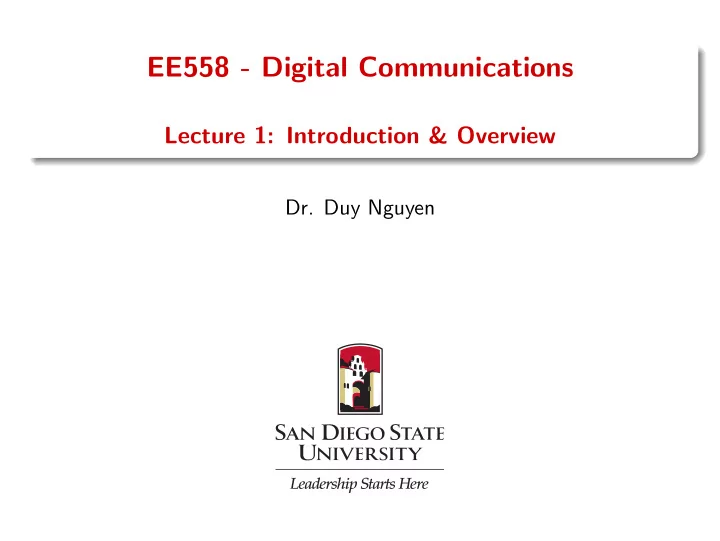

EE558 - Digital Communications Lecture 1: Introduction & Overview Dr. Duy Nguyen
Outline Course Information 1 Introduction to Digital Communications 2 Course Information 2
Administration Hours and Location ◮ Lectures: TTH 12:30 – 13:45 ◮ Location: SH-127 ◮ Office hours: Tue 14:00 – 16:00 or by email appointment Course webpage: http://engineering.sdsu.edu/˜nguyen/EE558/index.html Instructor: Dr. Duy Nguyen ◮ Office: ENG-408 ◮ Phone: (619) 594 2430 ◮ Email: duy.nguyen@sdsu.edu ◮ Webpage: http://engineering.sdsu.edu/˜nguyen Grader: Ms.Srilakshmi Alla ◮ Email: shrilaksmialla94@gmail.com Course Information 3
Syllabus Prerequisite ◮ EE 458 – Analog and Pulse Communication Systems ◮ Knowledge of MATLAB programming References 1. B. Sklar, Digital Communications: Fundamentals and Applications , 2nd Ed., Prentice Hall, 2001. 2. J. Proakis, Digital Communications , 4th Ed., McGraw-Hill, 2000. Homeworks: Bi-weekly, Total: 7 (6 best will be chosen). Late submission: maximum 1 day, 20% score deducted Assessments: only textbooks, slides and lecture notes are allowed in Quizzes and Exams ◮ Homeworks: 20% ◮ 3 Quizzes: 15% (25-minute each) ◮ 2 Midterm Exams: 30% (1-hour and 15-minute each) ◮ Final Exam: 35% (2-hour) Course Information 4
Syllabus Week Day Task Week Day Task 1 TU First day of class 9 TU Aug 29 TH Oct 24 TH Quiz 2 2 TU HW1 out 10 TU HW5 out, HW4 due Sep 5 TH Oct 31 TH 3 TU 11 TU Sep 12 TH Nov 7 TH Midterm Exam 2 4 TU HW2 out, HW1 due 12 TU HW6 out, HW5 due Sep 19 TH Nov 14 TH 5 TU 13 TU Sep 26 TH Quiz 1 Nov 21 TH Thanksgiving 6 TU HW3 out, HW2 due 14 TU HW7 out, HW6 due Oct 3 TH Nov 28 TH Quiz 3 7 TU 15 TU Oct 10 TH Midterm Exam 1 Dec 5 TH 8 TU HW4 out, HW3 due 16 TU HW7 due Oct 17 TH Dec 12 TH Course Summary Course Information 5
Topics to Cover Related Background ◮ Signals and systems ◮ Probability and random processes Sampling and quantization techniques Noise figures and noise temperature of systems Communication link analysis and link budgets Baseband binary modulation techniques Optimum receiver design and performance Communication over band-limited channels (if time permits) Equalization and multi-carrier transmission (if time permits) Course Information 6
Outline Course Information 1 Introduction to Digital Communications 2 Introduction to Digital Communications 7
Analog and Digital Amplitude Modulations Analog message 1 0 −1 0 0.5 1 1.5 2 2.5 3 3.5 4 4.5 5 t 1 AM signal 0 −1 0 0.5 1 1.5 2 2.5 3 3.5 4 4.5 5 t Digital message 1 0 −1 0 0.5 1 1.5 2 2.5 3 3.5 4 4.5 5 t BASK signal 1 0 −1 0 0.5 1 1.5 2 2.5 3 3.5 4 4.5 5 t Introduction to Digital Communications 8
What is Digital Communication? x ( t ) x ( t ) t t 0 (a) (b) x ( t ) x ( t ) T s t t 0 T s 0 (d) (c) Introduction to Digital Communications 9
Why Digital Communications? Transmitted AM 1 0 −1 0 0.5 1 1.5 2 2.5 3 3.5 4 4.5 5 t Received AM 2 0 −2 0 0.5 1 1.5 2 2.5 3 3.5 4 4.5 5 Transmitted BASK t 1 0 −1 0 0.5 1 1.5 2 2.5 3 3.5 4 4.5 5 Received BASK t 2 0 −2 0 0.5 1 1.5 2 2.5 3 3.5 4 4.5 5 t Introduction to Digital Communications 10
Why Digital Communications? Transmitted AM 1 0 −1 0 0.5 1 1.5 2 2.5 3 3.5 4 4.5 5 t Received AM 5 0 −5 0 0.5 1 1.5 2 2.5 3 3.5 4 4.5 5 Transmitted BASK t 1 0 −1 0 0.5 1 1.5 2 2.5 3 3.5 4 4.5 5 Received BASK t 5 0 −5 0 0.5 1 1.5 2 2.5 3 3.5 4 4.5 5 t Introduction to Digital Communications 11
Regenerative Repeater in Digital Communications Severely Original pulse Some distortion Degraded Regenerated degraded 1 2 3 4 5 Propagation distance Digital communications: Transmitted signals belong to a finite set of waveforms → The distorted signal can be recovered to its ideal shape, hence removing all the noise Analog communications: Transmitted signals are analog waveforms, which can take infinite variety of shapes → Once the analog signal is distorted, the distortion cannot be removed Introduction to Digital Communications 12
Block Diagram of a Communication System Synchronization Source Sink Transmitter Channel Receiver (User) (User) (a) Transmitter Receiver Source Channel De- Channel Source Modulator Encoder Encoder modulator Decoder Decoder (b) Note: “Synchronization” block is only present in a digital system Introduction to Digital Communications 13
Digital vs. Analog Advantages: Digital signals are much easier to be regenerated Digital circuits are less subject to distortion and interference Digital circuits are more reliable and can be produced at a lower cost than analog circuits It is more flexible to implement digital hardware than analog hardware Digital signals are beneficial from digital signal processing (DSP) techniques Disadvantages: Heavy signal processing Synchronization is crucial Larger transmission bandwidth Non-graceful degradation Introduction to Digital Communications 14
Digital Communications Communication System Source of User of Transmitter Receiver information information Message Estimate signal of message Channel signal Transmitted Received signal signal The main objective of a communication system is the transfer of information over a channel Digital communication: transmitted signals belong to a finite set of waveforms Estimate of message signal: decision-making regarding the digital meaning of that waveform Performance is usually expressed as bit-error-rate (BER) Introduction to Digital Communications 15
Terminologies Information source Character and alphabet Bit and bit stream Symbol Baud Digital waveform Data rate BER Introduction to Digital Communications 16
Recommend
More recommend